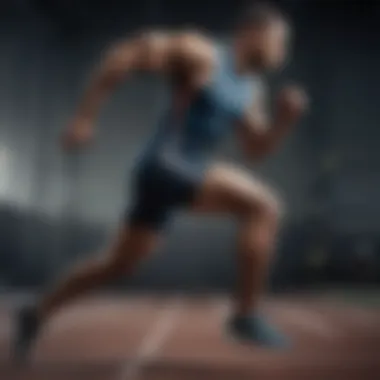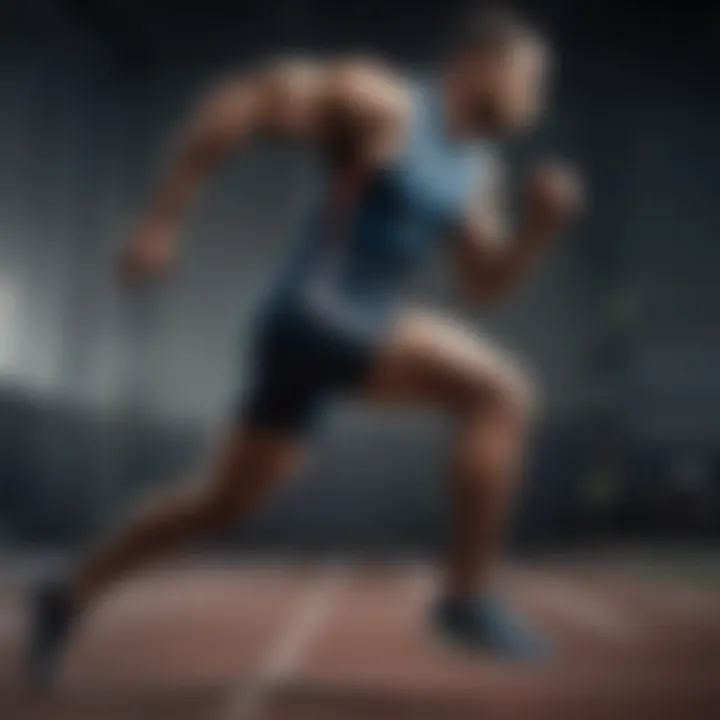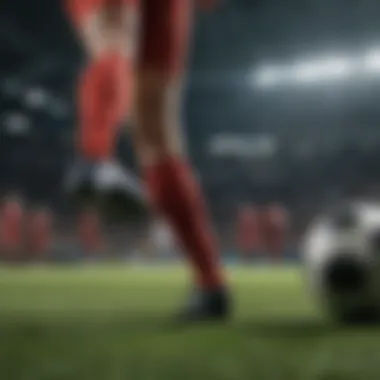Advancing Athletic Performance Through Biomechanics


Intro
Sports biomechanics sits at the intersection of mechanical engineering and biological sciences, creating a unique discipline that seeks to improve athletic performance and minimize injury risks. This field applies principles from physics to the human body, allowing for a deeper understanding of the mechanics involved in sports activities. Recognizing the significance of this knowledge can fundamentally change how athletes train, compete, and recover.
By analyzing movements and forces, sports biomechanics opens a pathway to refine techniques, optimize equipment, and design specific training protocols. The insights gained can lead to innovative strategies that enhance performance and promote safety in various sporting activities. This article will explore fundamental concepts, methodologies, and applications of biomechanics while shedding light on emerging technologies that shape this field.
Research Overview
Summary of Key Findings
Research in sports biomechanics reveals crucial data regarding movement efficiency and effectiveness. For instance, studies indicate that a proper understanding of joint mechanics can lead to better performance in sports such as running, swimming, and soccer. Additionally, biomechanics plays a vital role in injury prevention; understanding the loads placed on muscles and joints can help in designing targeted exercise programs.
Importance of the Research in Its Respective Field
The research conducted within this field is indispensable for athletes, coaches, and sports scientists. Insights gleaned from biomechanics can inform training regimens, help in recovery plans, and guide equipment design. As the sports industry evolves, the integration of biomechanics with sports technology continues to offer remarkable possibilities.
Methodology
Description of the Experimental or Analytical Methods Used
Various methods are employed in sports biomechanics research. These include motion capture analysis, force plate measurement, and electromyography. By capturing movements with high precision, researchers can analyze how different athletes perform under various conditions.
Sampling Criteria and Data Collection Techniques
Sampling in biomechanics often involves selecting participants based on specific criteria such as age, skill level, and type of sport. Data collection techniques can vary but primarily focus on capturing quantitative data to analyze mechanics effectively.
Understanding these components is crucial to comprehending the complexities of sports biomechanics.
Understanding Sports Biomechanics
Sports biomechanics is a crucial domain that examines the mechanical aspects of human movement in the context of athletic performance. This field provides insights into how the body functions during sports activities, revealing ways to enhance performance and minimize injury risks. Understanding sports biomechanics integrates principles from mechanics, physiology, and anatomy to form a comprehensive approach to athletic training and rehabilitation.
The importance of sports biomechanics cannot be overstated. Athletes and coaches can utilize this knowledge to improve technique and efficiency in movements. Such insights lead to not only improved performance but also longer athletic careers by focusing on injury prevention and recovery strategies. The scientific study of biomechanics lays the foundation for evidence-based practices in sports, driving the continual evolution of training methodologies.
Definition and Scope
Sports biomechanics is defined as the study of forces and their effects on the human body in motion during sport activities. It encompasses a wide range of topics including the analysis of human motion, the mechanical laws governing these motions, and the interactions between the athlete and the environment. The scope of this field is broad, covering various sports disciplines from athletics to team sports, and even extending to recreational activities.
Scope in sports biomechanics includes:
- Movement Analysis: Examining how athletes perform specific tasks and identifying areas for improvement.
- Force Assessment: Understanding how forces produced by movements affect performance and injury risk.
- Equipment Design: Informing the design of gear and technology that optimizes performance and safety.
Historical Context
The history of sports biomechanics dates back to ancient civilizations where the mechanics of human movement were observed but not formally studied. However, it began to take shape as a discipline in the 19th century with advances in anatomy and physics. Early contributions were made by individuals such as Eadweard Muybridge, whose pioneering work in motion photography provided insights into human motion.
As technology progressed, so did the field of biomechanics. The advent of motion capture technology in the late 20th century allowed for more precise analysis of movements. This advancement enabled researchers and practitioners to develop increasingly sophisticated tools for examining athletic performance. Today, sports biomechanics is recognized as an essential area of research and practice, impacting sports science, athlete training, and injury prevention strategies worldwide.
Key Concepts in Biomechanics
Biomechanics serves as a foundational pillar in understanding athletic performance and injury prevention. It encompasses the study of forces and motion in sports, kinematics, and kinetics of human movement, as well as the transfer and usage of energy. Each of these elements contributes significantly to how athletes perform, recover, and improve their techniques. This section will explore these key concepts and illuminate their critical roles in the domain of sports biomechanics.
Forces and Motion in Sports
Forces are a central theme in biomechanics. They define how athletes interact with their environment, their equipment, and their own bodies. The study of forces in sports involves understanding both external forces, such as gravity and air resistance, and internal forces generated by muscles and connective tissues.
In practice, the application of forces affects motion. For instance, when a sprinter pushes off the track, the force they exert propels them forward. Recognizing the intricacies of these dynamics allows coaches and athletes to enhance speed and power. The following aspects are important in this context:
- Force Production: Athletes must maximize force production to facilitate efficient movement. Training programs often focus on strength and explosiveness to improve these metrics.
- Force Application: The angle and direction in which forces are applied can greatly impact performance. It is essential for athletes to learn optimal techniques for various sports to reduce energy wastage.
- Force Interaction: Understanding how different forces interact during an athletic event helps in predicting outcomes and improving techniques systematically.
Kinematics and Kinetics
Kinematics deals with the description of motion without necessarily explaining the causes. It examines how an athlete moves through space, focusing on parameters like velocity, acceleration, and displacement. Kinetics complements this by investigating the forces that cause these movements. This interplay is crucial for analysis and improvement of performance.
Important points to consider include:


- Motion Analysis: Athletes can benefit from detailed motion analysis through tools like video analysis and wearable sensors. This data is crucial for understanding momentum, efficiency, and technique.
- Biological Feedback: Kinematic measurements provide athletes with feedback on their technique, allowing for real-time adjustments.
- Force Dynamics: Kinetics investigates how forces affect the body’s motion, leading to insights on how to reduce injury risks and enhance performance in practical scenarios.
Energy Transfer and Usage
Energy transfer in the body during physical activity is critical to performance. Athletes rely on various energy systems, such as anaerobic and aerobic, to fuel their activity. Understanding how to optimize energy transfer can lead to significant performance gains.
Key considerations include:
- Energy Conversion: Athletes must learn to convert stored energy into kinetic energy effectively, which is crucial during explosive movements. This efficiency defines overall performance in sports, especially in high-intensity events.
- Energy Depletion and Recovery: Recognizing patterns of energy depletion during training and competition allows for better recovery strategies. Athletes trained in managing energy levels can improve their stamina and effectiveness.
- Metabolic Efficiency: Improving metabolic processes can enhance performance and reduce fatigue. This consideration leads to targeted nutrition and training programs that can aid athletes in achieving their goals.
In summary, understanding the key concepts in biomechanics is not just academic; it directly influences the way performance is monitored, analyzed, and improved in athletics. A deep grasp of these elements can ultimately enable better training outcomes and a decrease in injury rates, positioning biomechanics as a critical area of study in sports science.
By focusing on these key concepts, athletes, coaches, and researchers can translate biomechanical principles into actionable strategies that refine performance and promote longevity in sports.
Applications in Athletics
The domain of sports biomechanics is essential in optimizing athletic performance and safeguarding against injuries. In an increasingly competitive sports environment, athletes and coaches seek advanced methods to enhance capabilities and maintain health. The application of biomechanical principles offers concrete benefits in various aspects of athletic training and competition.
Performance Enhancement
Performance enhancement is a pivotal aspect of biomechanics in athletics. By analyzing movements and mechanics of different sports, coaches can identify key areas for improvement. This involves assessing factors such as body posture, movement efficiency, and force generation. Different parameters influence the way an athlete performs, and biomechanics provides the tools to measure these parameters effectively.
Athletes who integrate biomechanical analysis into their training regimes often experience significant improvements in their performance metrics. For example, sprinters can modify their stride length and frequency based on data collected during sprinting analysis. Similarly, throwers can enhance their throwing techniques by understanding the optimal angles and velocities to maximize distance. Some helpful techniques include:
- Gait Analysis: Used in track and field to improve running mechanics.
- Swing Analysis: Beneficial in sports like golf or baseball to refine swing mechanics.
This data-driven approach fosters a culture of precision in training, making it possible for athletes to reach new heights.
Injury Prevention and Rehabilitation
Injuries are a reality of sports, and injury prevention is paramount for athletes. Biomechanics plays a crucial role in understanding the mechanisms leading to injuries. By analyzing an athlete's movements, practitioners can identify risky biomechanical patterns that may predispose them to injuries.
For instance, excessive force on joints or inappropriate landing mechanics can result in serious injuries. By using biomechanical assessments, trainers can develop tailored intervention strategies. These might include:
- Strengthening Exercises: To build resilience in specific muscle groups.
- Corrective Drills: To improve movement patterns that might lead to injuries.
In rehabilitation, biomechanics helps provide a structured approach for athletes recovering from injuries. Through targeted exercises and assessments, injured athletes can return to their sport more effectively and safely.
Technique Optimization
Optimizing technique is another vital application of biomechanics in athletics. This involves examining and refining the ways in which athletes execute their movements. Techniques that seem natural to an athlete might nonetheless harbor inefficiencies that can be remedied through biomechanical study.
Utilizing motion capture technology and force plates, sports scientists can analyze movements in real-time. They can then relay feedback to athletes regarding their posture, joint angles, and overall movement execution. Key benefits include:
- Improved Coordination: Enhancing how different body parts work together during athletic performance.
- Faster Learning: Athletes can quicker assimilate new techniques when provided with precise biomechanical feedback.
Applying these insights in training not only optimizes execution but also allows athletes to refine their competitive edge.
Biomechanics is not just a scientific analysis; it serves as a foundation for developing safe and effective sports techniques.
Biomechanical Analysis Techniques
Biomechanical analysis techniques are essential in the field of sports biomechanics as they offer valuable insights into the mechanics behind human movement. Through these methods, coaches, athletes, and researchers can evaluate performance, minimize injuries, and enhance training. The techniques are diverse and cater to different aspects of human motion.
Key benefits include:
- Accurate Data Collection: These techniques allow for precise measuring of forces, motion, and various physiological parameters during sports activities.
- Performance Enhancement: By analyzing specific movements, adjustments can be made to optimize techniques, leading to improved performance.
- Injury Prevention: Identifying biomechanical faults can help in crafting preventive strategies to reduce the risk of injuries.
While these techniques can provide extensive information, certain considerations should also be taken into account:
- Cost of Equipment: Advanced technologies may require significant investment.
- Data Interpretation Expertise: Proper analysis and understanding of the data are crucial for making informed decisions.
Together, these factors showcase the pivotal role aviation of biomechanical analysis techniques plays in modern sports practice.
Motion Capture Technology


Motion capture technology has transformed the way biomechanics is studied in sports. This sophisticated tool allows for the detailed analysis of athlete movements by recording their motion in real-time. Sensors, cameras, and other devices track body movements, providing a high level of accuracy.
Some important features include:
- 3D Analysis: This technology creates a three-dimensional representation of movements which is invaluable for understanding complex motions.
- Real-Time Feedback: Athletes can receive immediate feedback on their performance, making it possible to make rapid adjustments during training sessions.
- Comprehensive Motion Assessment: It can evaluate a wide range of motions, from running and jumping to intricate sport-specific actions.
In terms of applications, motion capture is widely used in professional sports, rehabilitation, and research settings. Using this technology, trainers can refine techniques, thus providing a competitive edge.
Force Plate Measurements
Force plates are another cornerstone in biomechanical analysis. They measure the ground reaction forces generated during an athlete's movements. The data gathered from these plates can reveal key aspects of an athlete's performance.
Key elements include:
- Force Magnitude: Understanding how much force an athlete generates helps in determining the effectiveness of their technique.
- Balance and Stability: Assessment of balance can help identify weaknesses in an athlete's performance that need addressing.
- Gait Analysis: The measurement of forces during running or jumping can offer insights into gait patterns and potential areas for improvement.
Force plate measurements are critical in both performance analysis and rehabilitation, as they help in designing tailored programs for athletes recovering from injuries.
Computer Simulations
Computer simulations provide a powerful platform for predicting how changes in technique or training regimens might affect performance. By using mathematical models, researchers and coaches can simulate movements without the need for physical trials.
Advantages of computer simulations include:
- Risk Minimization: Testing new techniques virtually reduces the risk of injury during live training.
- Design Flexibility: Adjustments to techniques can be assessed without significant downtime for the athletes.
- Long-term Projections: Simulations allow for the forecasting of performance over longer periods, aiding in strategic planning for athletes.
These simulations complement physical techniques and allow for a more comprehensive analysis of performance, providing a multifaceted view of athletic mechanics.
"The integration of technology in sports biomechanics has led to unprecedented advancements in training and analysis that were unimaginable just a few decades ago."
The Role of Technology
Technology plays a critical role in the advancement of sports biomechanics, driving improvements in performance and safety for athletes. As the boundaries of human capabilities are pushed, incorporating technological innovations becomes essential. The intersection of technology and biomechanics offers unique solutions to analyze movements, optimize techniques, and provide real-time feedback. This section highlights several dimensions where technology significantly impacts sports biomechanics, focusing on wearable devices, sophisticated data analytics, and cutting-edge research trends.
Wearable Technology in Sports
Wearable technology has gained substantial traction in the sports world. Devices such as smart watches, fitness trackers, and specialized sensor suits enable athletes and coaches to gather valuable performance metrics. These metrics include heart rate, speed, acceleration, and movement patterns. The data collected can be analyzed to understand the athlete's physical state, fatigue levels, and overall performance.
Benefits of wearable technology include:
- Real-time monitoring: Athletes can receive instant feedback during training or competition.
- Customization: Training regimens can be tailored to individual athlete needs through data-driven insights.
- Injury prevention: By tracking performance and detecting unusual movement patterns, coaches can intervene before injuries occur.
Wearable technology continues to evolve with enhanced features, making it integral to modern training protocols. These advancements not only aid athletes but also benefit rehabilitation programs by tracking recovery progress.
Data Analysis and Interpretation
Data analysis is vital in the realm of sports biomechanics. As the volume of data collected through various technologies increases, the challenge lies in interpreting this information effectively. Advanced analytics software can transform raw data into actionable insights.
Key components of data analysis in biomechanics include:
- Kinematic analysis: Understanding body movements helps refine techniques and improve skills.
- Kinetic analysis: Measuring forces exerted during movements aids in performance evaluation.
- Statistical methods: These methods assist researchers in confirming hypotheses and understanding performance variables.
An effective data analysis strategy allows coaches and scientists to make informed decisions. Interpreting data correctly can reveal trends that lead to performance enhancements or injury prevention strategies.
Emerging Trends in Biomechanics Research
Research in biomechanics is continuously evolving, with technology leading the way. New trends are reshaping how analysts, scientists, and athletes approach performance and training methodologies.
Some emerging trends include:
- Integration of Artificial Intelligence (AI): AI can help in predictive analytics, allowing for proactive adjustments in training.
- Use of Virtual Reality (VR): VR technology offers immersive training experiences, simulating live sports scenarios for skill enhancement.
- 3D motion capture advancements: As motion capture technology progresses, more accurate data can be gathered on fluid body movements and joint angles, contributing to a deeper understanding of athletic dynamics.
These trends signify a future where biomechanics benefits from continuous technological advancement. Understanding these innovations will be vital for students, researchers, and professionals in the field.
"The fusion of biomechanics and technology creates opportunities previously unimagined for athletes looking to gain an edge in performance."


Ethics and Challenges
The intersection of biomechanics and sports brings forth numerous ethical and practical challenges. As we explore this domain, it becomes essential to consider how these aspects can influence research outcomes and athletic practices. Ethical considerations ensure that research methods honor the rights and wellbeing of athletes while also upholding scientific integrity. Challenges also emerge as the field evolves, warranting a focus on responsible innovation and application of biomechanics.
Ethical Considerations in Biomechanical Research
Research in sports biomechanics often involves extensive data collection from athletes. This process can raise ethical questions. Consent is paramount. Athletes must understand what participation entails and how data will be used. Informed consent ensures that athletes are not just subjects in experiments but active participants in the research process.
Moreover, there is a risk of exploitation in this field. Athletes might feel pressured to participate in studies that could benefit their sport or organization. Fair treatment necessitates clear communication regarding any potential risks. Researchers are responsible for safeguarding their subjects’ mental and physical health. Findings must be shared transparently to promote trust within the sports community.
"Ethics in research is not just a guideline; it's a commitment to respect and understand the human element in scientific inquiry."
Future Challenges in the Field
Looking ahead, several challenges are apparent in sports biomechanics. As technology continues to advance, there is a growing concern over data privacy. Players' personal performance data needs protection to prevent misuse. Establishing robust protocols for data handling is essential
Another significant challenge is the implementation of findings in real-world settings. Theoretical research does not always translate effectively into practice. Ensuring that coaches and athletes can apply biomechanical principles to improve performance must be a priority.
Finally, the balance between innovation and traditional methods deserves discussion. New technologies and methodologies should enhance rather than replace existing practices. Maintaining a connection with foundational principles in biomechanics is necessary, even as the sport evolves.
In summary, tackling ethical considerations and future challenges is vital for the integrity and advancement of sports biomechanics. As the field matures, addressing these elements will help ensure a responsible approach to athlete performance and well-being.
Integrating Biomechanics with Other Disciplines
Integrating biomechanics with other disciplines is essential in enhancing the effectiveness of sports science. The relationship between biomechanics and fields like sports medicine and sports training is particularly significant. This collaboration brings together mechanical analysis and biological understanding, which creates a holistic approach to athletic performance and injury prevention.
Collaboration between different disciplines can result in better athlete monitoring, targeted rehabilitation, and optimized training methods. By working together, biomechanists and medical professionals can share insights, fostering innovation and improving outcomes for athletes. This approach also emphasizes the need for comprehensive strategies that encompass physical, mental, and technical aspects of sports.
Collaboration with Sports Medicine
The partnership between biomechanics and sports medicine is critical for developing preventative strategies and rehabilitation protocols. Sports medicine professionals focus on the treatment and prevention of injuries, while biomechanics provides the necessary tools to analyze movement patterns.
Key aspects of this collaboration include:
- Data Sharing: Biomechanics can offer valuable data on movement efficiency, which helps sports medicine practitioners identify risk factors for injuries.
- Protocol Development: Joint efforts can lead to creating tailored rehabilitation programs, accounting for individual biomechanics and physical capabilities.
- Continuous Feedback: Regular interaction between biomechanists and sports medicine experts can monitor athlete progress and adapt treatments as needed.
This multidisciplinary approach aims to maintain athletes' health, enhance recovery processes, and improve performance outcomes.
Interdisciplinary Approaches in Sports Training
Sports training benefits greatly from integrating biomechanical principles. Coaches, trainers, and biomechanists can work together to analyze athletes' techniques, aiming to maximize performance while minimizing the risk of injuries.
Several elements highlight the benefits of this collaboration:
- Technique Analysis: Understanding movement mechanics can lead to improvements in technique. Coaches can fine-tune practices to emphasize biomechanical efficiency, helping athletes perform better.
- Personalized Training Regimens: Incorporating biomechanical data can assist trainers in developing individualized plans that cater to the specific strengths and weaknesses of each athlete.
- Performance Enhancement: By using biomechanical insights, athletes can optimize their movement strategies, enhancing speed, agility, and endurance.
Overall, merging biomechanics with various disciplines like sports medicine and training creates comprehensive strategies that improve athletic performance and promote longevity in sports careers.
"Interdisciplinary collaboration enrichens the understanding of athlete performance and reduces the risk of injuries, making it a fundamental aspect of sports science."
This integration is essential for realizing athletes' potential and fostering a more profound understanding of their needs in a complex sports environment.
Epilogue and Future Directions
The exploration of sports biomechanics plays a crucial role in advancing athletic performance and minimizing the risk of injuries. Understanding the mechanical principles that govern human movement provides insights that are essential for athletes, coaches, and sports scientists. The conclusion of this article emphasizes the necessity of ongoing research in this field. Each step forward in knowledge can lead to better training techniques, enhanced equipment design, and improved rehabilitation methods. The integration of biomechanics with technology opens many doors, making it imperative to continue this research.
The Importance of Continued Research
Continued research in sports biomechanics is vital for a number of reasons. To begin with, the ever-evolving nature of sports requires adaptation in training methods. Ongoing studies inform athletes and coaches about effective ways to optimize performance. Furthermore, researching injury mechanisms helps in developing preventive strategies and rehabilitation techniques. Without new insights, it is difficult to keep pace with the increasing demands of competitive athletics. It is important to note that the collaboration between various disciplines such as biomechanics, physiology, and psychology enriches this research. This synergy fosters a deeper understanding of the athlete's needs.
Potential Innovations in Sports Biomechanics
The future presents significant potential for innovations in the field of sports biomechanics. One area that stands out is the integration of artificial intelligence and machine learning in biomechanical analysis. Through data-driven approaches, researchers can analyze vast amounts of data from athletes’ movements, leading to refined training regimens. Additionally, the enhancement of wearable technology is poised to revolutionize how athletes and coaches assess performance. Devices that collect real-time data regarding posture, force, and motion can provide immediate feedback. This feedback allows for immediate adjustments, leading to better performance outcomes. Potential innovations also exist in the domain of virtual and augmented reality, offering new methods for training and visualization.
In summary, the importance of continued research in sports biomechanics cannot be overstated. It allows for a progressive understanding of how to enhance athletic performance while ensuring safety. Innovations will not only change the landscape of training and recovery but can also impact the future of sports themselves.
"Advancements in sports biomechanics have the potential to redefine athletic excellence and safety standards for future generations."
Engaging in this ongoing research and embracing these innovations will be key to shaping the future of sports biomechanics.
Keywords: sports biomechanics, research, innovations, performance enhancement, injury prevention.





